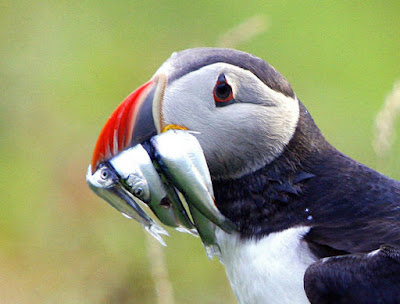An Atlantic puffin with a mouthfull of
small fish stands on Norway's Runde island in this file photo from 2007.
The Atlantic puffin offers an example of what can happen with
overfishing. When herring stocks in the Norwegian Sea were overfished
and crashed in the 1960s, the puffins had trouble reproducing and their
population plummeted by 64 per cent.
Fishing can have devastating effects on seabirds. Not only do they
get snagged on hooks and tangled in nets, but chronic overfishing can
deprive the birds of their prey — the same small fish that fishermen are
catching.
Now a study has identified what appears to be a universal threshold
for danger: When the biomass of so-called forage fish drops below
one-third of its maximum, seabirds of many species start to have fewer
chicks.
“This is one of the most important seabird papers to be published in
some time,” comments conservation biologist Dee Boersma of the
University of Washington, Seattle, who was not involved in the research.
The findings demonstrate the widespread reliance of seabirds on small forage fish, Boersma says.
To protect the birds, the papers’ authors call for lower harvest levels of forage fish.
“The problem remains that most fisheries are not properly managed and
controlled,” says co-author Philippe Cury of the Institute of Research
for Development in Sète, France.
Around the world, about 25 per cent of forage fish stocks have collapsed, Cury says.
A classic example of seabirds that suffered from overfishing is the
Atlantic puffin in Norway. When herring stocks in the Norwegian Sea
crashed in the 1960s, the puffins had trouble reproducing and the
population plummeted by 64 per cent.
But how typical was that response, and at what point does trouble
begin for seabirds? To look for a general relationship between the
abundance of forage fish and birds’ breeding success, Cury and an
international team of researchers examined data on fish and 14 species
of seabirds from seven ecosystems around the world. The records ranged
from 15 to 47 years in length.
All bird species showed the same response, the team reports in the Dec. 23 issue of Science:
the number of fledglings per breeding pair started to decline when the
abundance of forage fish dropped below one-third of the maximum observed
amount.
“The biggest surprise was the consistency of the relationship,” says
co-author Ian Boyd, a mammalogist at the University of St. Andrews in
Scotland. “It bowled us all over.”
Boyd says that once prey become too scarce, hunting probably becomes
inefficient and the birds lack enough food to successfully raise as many
young.
Although seabirds are adapted for the vicissitudes of life — forage
fish numbers have large natural fluctuations — seabirds populations may
decline when fishing depresses levels for many years in a row. “It’s a
corrosive effect,” Boyd says.
“Keep one-third for the birds” — that would be a useful guide to
managing forage fisheries so that seabird populations remain resilient,
the authors say.

No comments:
Post a Comment